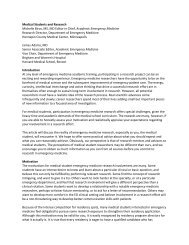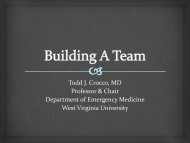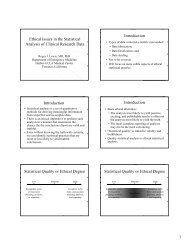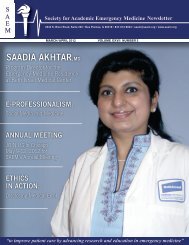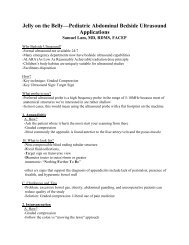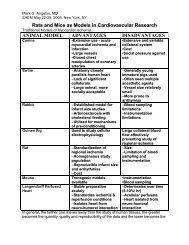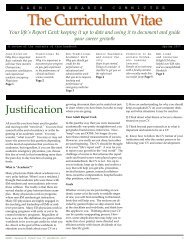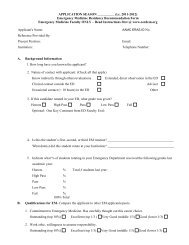Bringing Clinical Reasoning to Morbidity and Mortality.pdf
Bringing Clinical Reasoning to Morbidity and Mortality.pdf
Bringing Clinical Reasoning to Morbidity and Mortality.pdf
You also want an ePaper? Increase the reach of your titles
YUMPU automatically turns print PDFs into web optimized ePapers that Google loves.
David Gordon, MD<br />
Jeremiah Schuur, MD, MHS<br />
Joshua Wallenstein, MD
The presenters do not have any relevant<br />
commercial relationships or conflict of interests<br />
<strong>to</strong> disclose<br />
J. Schuur<br />
•Scientific Advisory Board of United HealthCare
• To structure M&M conference as a protected<br />
environment for non-judgmental case review, in<br />
order <strong>to</strong> foster professional growth<br />
• To identify systems issues <strong>and</strong> cognitive biases<br />
that underlie common errors<br />
• To review cognitive strategies that can help<br />
prevent a similar event next time
• Improve patient care<br />
• Reduce medical error<br />
• Maximize efficiency<br />
• Foster collaboration<br />
• Improve patient satisfaction
• The “direc<strong>to</strong>r”<br />
• The case<br />
• The presenter<br />
• The materials<br />
• The audience
• One individual with oversight of the M&M<br />
program<br />
• Collaborative skills are key<br />
• Background in quality <strong>and</strong> education<br />
• Set expectations of presenters <strong>and</strong> audience<br />
• Ensure men<strong>to</strong>rship
• Elements of a good case<br />
• Quality issues<br />
• System failures<br />
• Judgment errors<br />
• Near miss<br />
• Case selection<br />
• St<strong>and</strong>ard reporting<br />
• Key informants<br />
• Patient complaints<br />
• Anonymous reporting system
• Case investigation<br />
• Medical record<br />
• Involved parties<br />
• Presentation <strong>and</strong> public speaking skills<br />
• Interactive - discussion throughout case
• Begins with triage note (or earlier)<br />
• Presentation in real time<br />
• Scan or import images<br />
• De-identify
• Awake<br />
• Engaged<br />
• Key players should not reveal themselves or<br />
be revealed<br />
• Share what’s going on in your head
Cognitive <strong>and</strong> Systems Au<strong>to</strong>psy:<br />
Identifying Systems Fac<strong>to</strong>rs <strong>and</strong><br />
Cognitive Biases <strong>and</strong> in M&M<br />
Jeremiah Schuur, MD, MHS<br />
Department of Emergency Medicine<br />
Brigham & Women’s Hospital
• “Well, if it isn’t the Four<br />
Horsewomen of the<br />
Apocalypse. There’s a<br />
morbidity <strong>and</strong> mortality<br />
conference <strong>to</strong>morrow <strong>to</strong><br />
figure out who’s<br />
responsible for Foster’s<br />
death. And here’s the<br />
exciting news : I’m pretty<br />
sure it was one of you.”
Patient Fac<strong>to</strong>rs<br />
Task Fac<strong>to</strong>rs<br />
Staff Fac<strong>to</strong>rs (Individual)<br />
Traditional M&M<br />
-identify blame<br />
-personal failing<br />
Team Fac<strong>to</strong>rs<br />
Work Environment Fac<strong>to</strong>rs<br />
Systems<br />
Issues<br />
Organization / Management<br />
Institutional Context<br />
Modeled on Vincent C, et al, BMJ 2000. 320:777
• Cook County ED<br />
• Retrospective review of<br />
636 cases<br />
• Two physicians<br />
independently reviewed:<br />
• 4 categories phase of work<br />
(diagnosis, treatment,<br />
disposition, <strong>and</strong> public health)<br />
• contributing fac<strong>to</strong>rs that likely<br />
affected outcome (patient<br />
fac<strong>to</strong>rs, triage, clinical tasks,<br />
teamwork, <strong>and</strong> system).<br />
Cosby KS, et el. Characteristics of patient care management problems<br />
identified in emergency department morbidity <strong>and</strong> mortality investigations<br />
during 15 years. Ann Emerg Med. 2008 Mar;51(3):251-61, 261.
• Cook County ED<br />
• Retrospective review of<br />
636 cases<br />
• Two physicians<br />
independently reviewed:<br />
• 4 categories phase of work<br />
(diagnosis, treatment,<br />
disposition, <strong>and</strong> public health)<br />
• contributing fac<strong>to</strong>rs that likely<br />
affected outcome (patient<br />
fac<strong>to</strong>rs, triage, clinical tasks,<br />
teamwork, <strong>and</strong> system).<br />
Triage<br />
System<br />
<strong>Clinical</strong>:<br />
Task Based<br />
<strong>Clinical</strong>:<br />
Skill Set<br />
Teamwork<br />
<strong>Clinical</strong>:<br />
Affective<br />
influences<br />
Patient<br />
Diagnosis<br />
<strong>Clinical</strong>:<br />
<strong>Reasoning</strong><br />
Cosby KS, et el. Characteristics of patient care management problems<br />
identified in emergency department morbidity <strong>and</strong> mortality investigations<br />
during 15 years. Ann Emerg Med. 2008 Mar;51(3):251-61, 261.<br />
0% 20% 40% 60% 80% 100%
• Local ED environment (the microsystem):<br />
• Triage; Policies & Procedures; Equipment; Teamwork<br />
• Hospital environment (the macrosystem):<br />
• Equipment, Consultants, Boarding…<br />
• Hospital administration <strong>and</strong> third parties:<br />
• Policies & Procedures, Insurance policies…<br />
• Community level:<br />
• community services, EMS policies, healthcare access…
• Education Issues<br />
• Lack of knowledge of one or more practitioners<br />
• Technical Error<br />
• Error on performance of a truly indicated<br />
procedure<br />
• Judgment Issues<br />
• Adequate knowledge but incorrect judgment<br />
Modeled on: Lucey C, Winiger D, Shim R. “Towards a More Effective <strong>Morbidity</strong> <strong>and</strong> <strong>Mortality</strong><br />
Conference” APDIM Spring Meeting, 2004
• Commission <strong>and</strong> Omission bias:<br />
• Commission = tendency <strong>to</strong>ward action rather than<br />
inaction, due <strong>to</strong> obligation <strong>to</strong>ward beneficence.<br />
• Omission: tendency <strong>to</strong>ward inaction based on<br />
principle of nonmaleficence (first do no harm).<br />
• Hassle Bias: tendency <strong>to</strong> avoid difficult<br />
actions.<br />
• call in consultant at 3am<br />
• pelvic exam on hallway patient…<br />
Modeled on:Croskerry P. Achieving quality in clinical decision making: cognitive strategies <strong>and</strong> detection of bias. Acad Emerg Med. 2002<br />
Nov;9(11):1184-204.<strong>and</strong> Lucey C, Winiger D, Shim R. “Towards a More Effective <strong>Morbidity</strong> <strong>and</strong> <strong>Mortality</strong> Conference” APDIM Spring Meeting, 2004
• Ascertainment bias: decision-making is shaped by<br />
prior expectation; e.g. stereotyping <strong>and</strong> gender bias.<br />
• Availability Heuristic: judge things as being more<br />
likely, or frequently occurring, if they readily come<br />
<strong>to</strong> mind. Recent experience with a disease inflates<br />
its rank on the DDx.<br />
• “the last patient like this had PE”<br />
• Gambler’s fallacy: the belief that if a coin is <strong>to</strong>ssed<br />
ten times <strong>and</strong> is heads each time, the 11th <strong>to</strong>ss has a<br />
greater chance of being tails.<br />
• “We can’t see 3 patients in one shift with aortic dissection”<br />
Modeled on:Croskerry P. Achieving quality in clinical decision making: cognitive strategies <strong>and</strong> detection of bias. Acad Emerg Med. 2002<br />
Nov;9(11):1184-204.<strong>and</strong> Lucey C, Winiger D, Shim R. “Towards a More Effective <strong>Morbidity</strong> <strong>and</strong> <strong>Mortality</strong> Conference” APDIM Spring Meeting, 2004
• Anchoring: tendency <strong>to</strong> lock on<strong>to</strong> salient features in<br />
the patient’s initial presentation <strong>to</strong>o early in the<br />
diagnostic process, <strong>and</strong> failing <strong>to</strong> adjust this initial<br />
impression in the light of later information.<br />
• epigastric pain as upper abdominal pain, not chest pain.<br />
• Confirmation bias: tendency <strong>to</strong> look for <strong>and</strong> weight<br />
confirming evidence <strong>to</strong> support a diagnosis rather<br />
than evidence that refutes it, despite the latter<br />
often being more persuasive <strong>and</strong> definitive.<br />
• the WBC count is cited if it supports course of action.<br />
Modeled on:Croskerry P. Achieving quality in clinical decision making: cognitive strategies <strong>and</strong> detection of bias. Acad Emerg Med. 2002<br />
Nov;9(11):1184-204.<strong>and</strong> Lucey C, Winiger D, Shim R. “Towards a More Effective <strong>Morbidity</strong> <strong>and</strong> <strong>Mortality</strong> Conference” APDIM Spring Meeting, 2004
• Search satisfying: universal tendency <strong>to</strong> call<br />
off a search once something is found.<br />
• failure <strong>to</strong> thoroughly examining for additional<br />
gunshot wounds in a trauma patient.<br />
• Premature closure: tendency <strong>to</strong> shut down<br />
the decision-making process prematurely,<br />
accepting a diagnosis before it has been fully<br />
verified. Common.<br />
Modeled on:Croskerry P. Achieving quality in clinical decision making: cognitive strategies <strong>and</strong> detection of bias. Acad Emerg Med. 2002<br />
Nov;9(11):1184-204.<strong>and</strong> Lucey C, Winiger D, Shim R. “Towards a More Effective <strong>Morbidity</strong> <strong>and</strong> <strong>Mortality</strong> Conference” APDIM Spring Meeting, 2004
• Diagnosis momentum: once diagnostic labels are<br />
attached <strong>to</strong> patients they tend <strong>to</strong> stick. What might<br />
have started as a possibility gathers increasing<br />
momentum until it becomes definite.<br />
• Triage cueing: during triage labels get applied <strong>and</strong> patients<br />
get sorted <strong>to</strong> locations that ultimately influence<br />
downstream providers, leading <strong>to</strong> the maxim: ‘‘Geography<br />
is destiny.’’<br />
• Overconfidence Bias: over reliance on the opinions<br />
of the “expert” (PMD, consultant…)<br />
• the opinion of a surgeon about abdominal pain.<br />
Modeled on:Croskerry P. Achieving quality in clinical decision making: cognitive strategies <strong>and</strong> detection of bias. Acad Emerg Med. 2002<br />
Nov;9(11):1184-204.<strong>and</strong> Lucey C, Winiger D, Shim R. “Towards a More Effective <strong>Morbidity</strong> <strong>and</strong> <strong>Mortality</strong> Conference” APDIM Spring Meeting, 2004
• Aggregate bias: belief that aggregated data,<br />
such clinical decision rules, do not apply <strong>to</strong><br />
individual patients -- leads <strong>to</strong> errors of<br />
commission<br />
• ordering tests when none required.<br />
Modeled on:Croskerry P. Achieving quality in clinical decision making: cognitive strategies <strong>and</strong> detection of bias. Acad Emerg Med. 2002<br />
Nov;9(11):1184-204.<strong>and</strong> Lucey C, Winiger D, Shim R. “Towards a More Effective <strong>Morbidity</strong> <strong>and</strong> <strong>Mortality</strong> Conference” APDIM Spring Meeting, 2004
• Psych-out error: Psychiatric patients are particularly<br />
vulnerable <strong>to</strong> cognitive errors, especially <strong>to</strong><br />
fundamental attribution error: co-morbid medical<br />
conditions may be overlooked or minimized.<br />
• Sut<strong>to</strong>n’s slip: strategy of going for the obvious is<br />
Sut<strong>to</strong>n’s law. The slip occurs when possibilities other<br />
than the obvious are not given sufficient<br />
consideration. (Bank-robber Willie Sut<strong>to</strong>n is alleged<br />
<strong>to</strong> have <strong>to</strong>ld the judge that he robbed banks,<br />
‘‘because that’s where the money is!’’)<br />
Modeled on:Croskerry P. Achieving quality in clinical decision making: cognitive strategies <strong>and</strong> detection of bias. Acad Emerg Med. 2002<br />
Nov;9(11):1184-204.<strong>and</strong> Lucey C, Winiger D, Shim R. “Towards a More Effective <strong>Morbidity</strong> <strong>and</strong> <strong>Mortality</strong> Conference” APDIM Spring Meeting, 2004
Addressing Cognitive Biases:<br />
Forcing functions <strong>and</strong> other <strong>to</strong>ols<br />
David Gordon, MD<br />
Division of Emergency Medicine<br />
Duke University
No-Fault<br />
System<br />
Cognitive<br />
• Unusual presentation of<br />
disease<br />
• Patient refusal <strong>to</strong> be<br />
tested<br />
• Limitations in medical<br />
knowledge<br />
• Technical failures<br />
• Organizational failures<br />
• Testing not available<br />
• Inadequate supervision<br />
• Poor coordination of<br />
care<br />
• Knowledge<br />
• Judgment<br />
• Memory/Vigilance<br />
Graber M, Gordon R, Franklin N. Acad Med 2002;71:981-992
• Cognitive awareness<br />
• Cognitive debiasing strategies<br />
• Cognitive training
• Providing descriptions of cognitive biases <strong>and</strong><br />
examples of their adverse impact on decisionmaking<br />
• Metacognition: thinking about thinking.<br />
Reflection on the decision making process<br />
itself.
• Patients<br />
• Situations<br />
• Diagnoses
• High risk patients<br />
• “The young, the old, <strong>and</strong> the crazy”<br />
• The hostile, abusive, <strong>and</strong> in<strong>to</strong>xicated<br />
Unreliable his<strong>to</strong>ry, atypical presentations,<br />
negative visceral response
• The Return Visit<br />
• Diagnosis Momentum<br />
• Visceral Bias
• High risk times<br />
• Patient sign-out<br />
▪ Loss of information<br />
▪ Misinterpretation of new incoming data<br />
• High acuity or volume<br />
• End -of-shift (personal fatigue)
• High Risk Diagnoses<br />
• CP: MI, PE, TAD<br />
• Headache: SAH, meningitis, SDH<br />
• Abd pain: appendicitis, ec<strong>to</strong>pic , <strong>to</strong>rsion<br />
• Ortho: tendon & nerve injuries, foreign bodies
Heuristics or mental strategies <strong>to</strong> avoid bias<br />
Forced Thinking
• What else could it be?<br />
• Is there anything that<br />
doesn’t fit?<br />
• Is it possible that I have<br />
more than one problem?
• Adequacy<br />
• Are all the patient's findings<br />
(abnormal or normal) accounted for<br />
by the diagnostic hypothesis?<br />
Have I explained all the patient’s findings?<br />
• Coherency<br />
• Is the diagnostic hypothesis<br />
pathophysiologically consistent with<br />
all the clinical findings?<br />
Is there a non-fit?
High-risk<br />
Patients<br />
High-risk<br />
Times<br />
High-risk<br />
Diagnoses<br />
Cognitive<br />
Awareness<br />
Have I explained all the<br />
patient’s findings?<br />
Cognitive<br />
Strategies<br />
Could there be more than one<br />
problem?<br />
What else could it be?<br />
Have I considered worst-first?<br />
Is there a nonfit?
• Simulation – create clinical scenarios that are<br />
high risk for cognitive errors<br />
• Observation- training videos that contrast<br />
biased vs. unbiased approaches<br />
• Feedback<br />
• Immediate<br />
• M&M
M&M Case Discussions<br />
Decision-Making Issues<br />
• Cognitive Awareness/Diagnostic challenges: high risk patient,<br />
time, or diagnosis<br />
•Cognitive biases<br />
Systems Issues<br />
•E.g. difficulty with finding consultant, slow time for final<br />
radiology reads etc.<br />
Counterstrategies<br />
• Forced questions<br />
• Systems change or improvement
• Croskerry P. Achieving quality in clinical decision<br />
making: cognitive strategies <strong>and</strong> detection of bias.<br />
Acad Emerg Med. 2002 Nov;9(11):1184-204.<br />
• Patient Safety in Emergency Medicine (Textbook)<br />
• Jerome Groopman. How Doc<strong>to</strong>rs Think.





